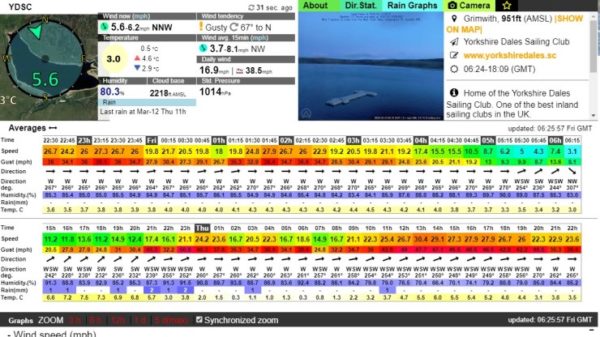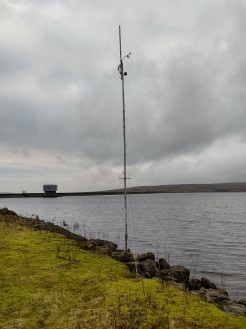A new weather station has been installed at Yorkshire Dales SC after a club membership survey highlighted it was on the wish list for many sailors and particularly its windsurfers.
The Holfuy all-in-one automatic weather station chosen by the club provides live and historic data for wind speed, direction and temperature. The club also added pressure, humidity and rainfall sensors, with the complete package costing around £1,000.
Replacing an old basic weather station at the club which had not been working for some time, it was sourced and set up by club bosun Tony Dalton with support from Vince Grealy and other members and went live at the end of January 2020.
The club has also installed a third webcam overlooking the windsurfing area in response to a request from the fleet, adding to the views already available over the middle of Grimwith Reservoir and towards the dam wall from its existing webcams.
The weather station takes snapshots from the webcams at 15 minute intervals – with an animated time lapse available – and all of the weather station and webcam data is accessible via a summary panel generated by Holfuy, which was easily embedded onto the home page of the Yorkshire Dales SC website When clicked on, a new window opens showing more detailed information, including trend graphs and history over up to five days.
In addition to the data appearing in a customised panel on the club’s website, Holfuy hosts the data on its own website – as can be seen here – and members can download an Apple or android app to see all the live data on a phone or tablet.
Output from the weather station also integrates with Windguru’s Yorkshire Dales forecast so that this page now shows the live wind speed and direction from the club as well.
“It means that if people are travelling a long way to come to the club to sail they can look at the forecast, see what the weather is doing now, look at the actual weather history over the last few hours, and make an informed decision,” says Tony.
“We decided to invest in a new weather station to benefit club members, a lot of whom travel quite a long way to get to the club. I’m only 35 minutes away and the weather can be so different at home – there might be no wind there and yet it can be quite strong at the club, so having something located right there at the side of the water is perfect.
“There’s an awful lot of interest in it at the club and it’s a great talking point. It’s also good from a club point of view because when people ask, ‘can we have this?’ – to be able to deliver on that helps people to engage in the club and want to get involved. It’s good to keep improving things and moving forward.”
 Top tips
Top tips
The starting point for Yorkshire Dales SC was to assess the various weather stations on the market – including capital and running costs and connectivity – then look in depth at their preferred option. For other clubs thinking about installing or upgrading their own weather station, Tony has shared his own experiences of choosing and setting up the Holfuy system chosen by the club:
Research: Commercial units can be as much as £5,000; a basic unit from Hungary-based Holfuy measuring wind speed starts at around 700-800 Euros, and the Yorkshire Dales SC version with additional sensors was around £1,000. Whatever weather station you are considering, Tony suggests checking with existing users for their feedback: “I did a lot of research and contacted three different users of the Holfuy system to see if people had been using it successfully, picking places that would be wild in terms of the weather at certain times of the year: the harbour master at Blakeney on the Norfolk coast, a yacht chartering business in St Peter Port on Guernsey and a parascending/glider operation in the Welsh mountains. They all came back with very positive experiences of using it.”
Power: Will you be able to connect your weather station to a power supply? The Yorkshire Dales weather station is powered by a solar panel – and even with short winter days and grey skies, the battery only dips to 97% and by the end of each day is back up to 100%. Flexibility to reduce the frequency at which data is updated can help to reduce power consumption if necessary.
Location: This will depend on whether your weather station needs mains power or is operated via a solar panel, in which case access to good daylight will be a factor, alongside of course clear air. Yorkshire Dales ruled out mounting its weather station on the club house, where wind readings would have been affected, and used an old Hobie cat mast which is relatively easy to take down for maintenance and allowed a good site to be chosen by the lake.
 Output: What do you want your weather station to tell you? Look at how customisable the weather station is in terms of readings and how it conveys the data. Standard devices will provide windspeed, direction and temperature. Yorkshire Dales SC added pressure, humidity and rainfall sensors as well for their weather station: “It’s very flexible,” says Tony. “You can choose the windspeed in mph or knots for example, and it keeps the data for five years, so historically we’ll be able to look back over the trends such as rainfall and water level.”
Output: What do you want your weather station to tell you? Look at how customisable the weather station is in terms of readings and how it conveys the data. Standard devices will provide windspeed, direction and temperature. Yorkshire Dales SC added pressure, humidity and rainfall sensors as well for their weather station: “It’s very flexible,” says Tony. “You can choose the windspeed in mph or knots for example, and it keeps the data for five years, so historically we’ll be able to look back over the trends such as rainfall and water level.”
Installation: Consider how easy it is to set up and whether there support available from the supplier. “It’s OK getting a smart piece of kit but if no-one can get it working, it soon becomes a liability. I wouldn’t say Holfuy is quite plug-and-play but it is relatively easy to install and you don’t need to be an IT guru to get it up and running. Holfuy actually hosts all the weather data, so it’s all done for you, and for people who aren’t techno geeks it’s a really good solution. The technical support is second to none. We were able to embed a view of the reservoir itself behind a compass so people can orientate themselves – that took a little working out but Holfuy were really helpful.”
Connectivity: The Yorkshire Dales SC weather station uses the GSM mobile phone network, which combined with solar power makes it completely self-contained and not relying on any power or IT functionality from the club. As Tony explains, “The beauty of it is that you don’t need to get cables to it or club Wi-Fi to interact with it – so as long as you have a phone signal it just sits there and does its own thing, which is really easy from an installation point of view. We have challenges with Wi-Fi at the club because we don’t have a landline and have limited band width, which is why wanted a SIM card system because then we’re not dependent on the club’s infrastructure to get the data and we could put the mast out in clear air.”
Running costs: Another factor to consider in choosing a weather station is running costs, which should ideally be minimal. Yorkshire Dales SC uses a data-only global M2M sim card costing around £3 a month, which automatically picks up the best signal – in this case a 2G rather than 3G network – to get the data from the device to Holfuy. There are no hosting costs from Holfuy and data only costs about £1.50 a month but the club added a text bundle, which enables Tony to text the weather station to change its settings or parameters. For example, if the weathervane is not pointing due north, it can be reconfigured without dropping the mast. Tony adds: “If it finds a really reliable 2G signal, like we did, the system can be forced to stay on that and it uses less power. It’s reckoned that to refresh the data every two minutes, the maximum data needed is 2MB a month!”
Maintenance: An accessible location or a mast which is easy to put up and take down will make it easier to access a weather station for maintenance. Tony expects the wind speed and direction indicators may need replacing after 2-4 years by virtue of spinning around non-stop, costing around £150 to replace the unit, while if the bearings go first, a set of those might be £20: “Probably the hardest part of the project was to come up with a suitable mast, which we’ve designed to be easy to drop down so if we need to service it, we can do that easily. Only time will tell how robust the weather station is but it comes with a 24 month warranty and from talking to other places who’ve had one for 18 months to two years, I’m comfortable about its resilience. In terms of the benefit to club members, I think it will be well worth the investment.”
Further information: Visit the club website at www.yorkshiredales.sc to see the weather station in action and for clubs and centres wanting to know more, Tony is happy to be contacted here.





Recent Comments